What are Sea Hares? - page 2
This is a place for general discussion and questions on Sea Hares.
For more background information see Page 1.
Related messages
Aplysia from Bay of Bengal
May 5, 2010
From: Rajesh Kumar
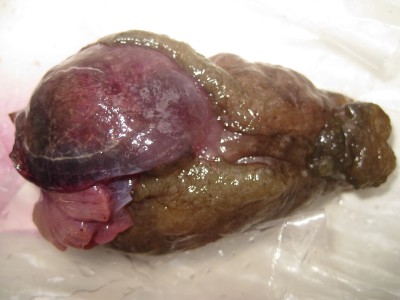
Dear Bill,
I have attached a photograph of nudibranch and I need your help for identification of that species.
Locality: Thondi, Gulf of mannar, Shore, Tamil nadu, India , Bay of Bengal, 05 April 2010, Intertidal. Length: 122mm. Photographer: Rajesh Kumar.R.K.
Rajesh Kumar
rk.rajeshkumar@yahoo.co.in
Kumar, R., 2010 (May 5) Aplysia from Bay of Bengal. [Message in] Sea Slug Forum. Australian Museum, Sydney. Available from http://www.seaslugforum.net/find/23586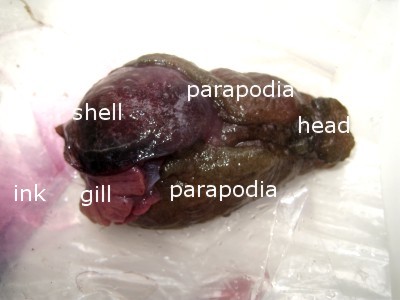
Dear Rajesh,
This is a Sea Hare rather than a nudibranch. If you follow the links on the Sea Hare Fact Sheet you will find quite a bit of background information on the family. I have labelled your animal so you can get a basic idea of its anatomy. The purplish colour at the back is the remains of the purple ink many sea hares produce.
It is a species of Aplysia but I am afraid its not possible to identify it to species in this state.
Best wishes,
Bill Rudman
Re: Food of Aplysia from Hawaii
January 13, 2009
From: Kate Werner
Concerning message #22142:
Thanks Bill.
I tried several types of algae and it didn't seem to be eating any of them. I returned him to rocky pools at a similar beach. I didn't realize algae exuded poison. Is there any way to keep live algae in a tank because I noticed my fish enjoying lying on it like carpet. He's a goby.
Kate
ekatewerner@hotmail.com
Werner, K., 2009 (Jan 13) Re: Food of Aplysia from Hawaii. [Message in] Sea Slug Forum. Australian Museum, Sydney. Available from http://www.seaslugforum.net/find/22149Dear Kate,
I am not an expert on keeping algae in aquaria, but as a general rule, brown and red algae in small aquarium systems where the water is not continually changed are not a good idea - especially if the algae are being eaten alive.
Best wishes,
Bill Rudman
Re: Food of Aplysia from Hawaii
January 12, 2009
From: Kate Werner
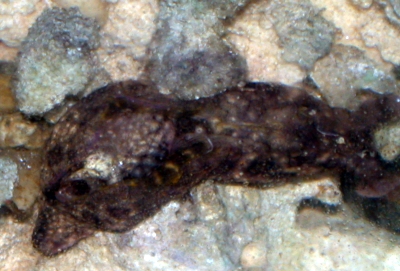
I found this sea hare washed up on shore with lots of algae. I took it and put in tank but doesn't seem to be eating its algae. Help me with diet or should I return to sea?
Locality: Kailua Beach, washed up , Oahu, Hawaii, Pacific, 09 January 2009, sand beach. Length: 6 centimetres. Photographer: Kate Werner.
Kate Werner
ekatewerner@hotmail.com
Werner, K, 2009 (Jan 12) Re: Food of Aplysia from Hawaii. [Message in] Sea Slug Forum. Australian Museum, Sydney. Available from http://www.seaslugforum.net/find/22142Dear Kate,
Your photos aren't that clear but it looks like you have a sea hare. Sea hares do eat algae, but they are pretty choosy on which species they eat. Just because they were washed up at the same time as a lot of algae it doesn't necessarily mean they algae they washed up with is their food. Often it just means that the algae and the sea hares were caught up in the same storm. One fairly common algae that most species of Sea Hare like is the green algae Ulva, which is commonly called 'sea lettuce' because it looks quite like a leaf of lettuce from the garden.
However most algae is difficult to keep alive in aquaria, and as they die they exude very poisonous chemicals into the aquarium water. Unless you can find some Ulva to try - which appears to be aquarium safe - my advice would be to put the Sea Hare back in a rock pool at the beach
Best wishes,
Bill Rudman
Re: Aplysia brasiliana from Texas, Gulf of Mexico
October 9, 2008
From: Georgia Doyle
Concerning message #10457:
I found the sea slug in Diggers National Park, New South Wales, Australia. Behind the flappy parts on the back of its back is an 'ink cannon' where it sprays purple/red coloured ink. It was found in shallow water in rock pools.
Locality: Rock pool off beach, 130cm, NSW Australia, Pacific Ocean, 07 July 2008, Rocky,slimy, seaweed . Length: 17cm. Photographer: No Photos taken.
Georgia Doyle
georgia.doyle@hotmail.com
Doyle, G., 2008 (Oct 9) Re: Aplysia brasiliana from Texas, Gulf of Mexico. [Message in] Sea Slug Forum. Australian Museum, Sydney. Available from http://www.seaslugforum.net/find/21956Dear Georgia,
You have certainly seen a Sea Hare, but it won't be Aplysia brasiliana, which is found only in the Atlantic. There are a number of species of Aplysia found in New South Wales. I suspect the two most likely ones you ave seen are Aplysia dactylomela and Aplysia sydneyensis. If you have a look at the Sea Hares Fact Sheet you will find links to a lot of general information on these fascinating animals.
Best wishes,
Bill Rudman
Strange phenomenon with Sea Hare
February 19, 2008
From: Ute Duvenhage
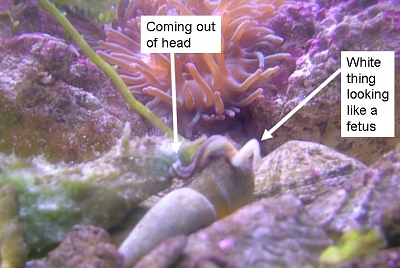
Hi,
We have a sea fish tank at home and enjoy watching all the species in there.
Today we saw something strange on our sea hare (we call it Shrek !). It is a strange long thing (like a tentacle) on the head (front of the sea hare). It does not seem to bother him, because he still moves around. At the end of this tentacle thing is a white piece, still attached to the tentacle. To me it nearly looks like the fetus of something (similar features). See attached photo.
We would appreciate it if you could explain to us what that is !
Thank you !
Ute
uteduvenhage@hotmail.com
Duvenhage, U, 2008 (Feb 19) Strange phenomenon with Sea Hare. [Message in] Sea Slug Forum. Australian Museum, Sydney. Available from http://www.seaslugforum.net/find/21225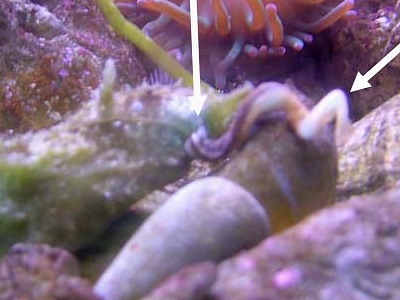
Dear Ute,
The strange spiral 'thing' is its penis. Usually it is sitting in a sac inside the body and is only everted like this when it is about to mate. Unfortunately they sometimes do this when they are 'sick'. I hope in the time it has taken me to answer your message it has recovered rather than died.
If you look carefully at your photo just where the penis attached to the side of the head you should be able to see a line running diagonally up to just below the rhight rhinophore or head tentacle. This is the sperm grrove which carries sperm from the reproductive opening at the front of the mantle cavity forward to the penis. You will see a better picture on the Sea Hare head Fact Sheet.
Best wishes,
Bill Rudman
Re: Sea hare being eaten by crab - Reunion Is.
February 9, 2008
From: Hugues Flodrops
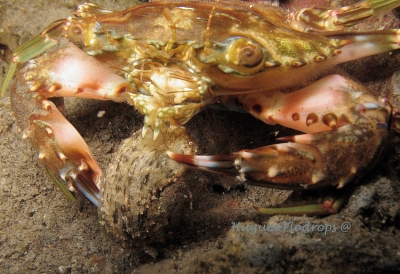
Concerning message #13926:
Dear Bill and Koh,
Here is a picture of another example of predation. This seahare was eaten by a crab during the night. Is it a Dolabella? Size of the crab about 100-120 mm.
Locality: Etang-Salé Permanent Pool, 2 metres, Reunion Island, Indian Ocean, 5 December 2007, Night. Length: 30 mm . Photographer: Hugues Flodrops.
Best regards.
Hugues.
hugues.flodrops@wanadoo.fr
Flodrops, H., 2008 (Feb 9) Re: Sea hare being eaten by crab - Reunion Is.. [Message in] Sea Slug Forum. Australian Museum, Sydney. Available from http://www.seaslugforum.net/find/21319Dear Hugues,
Thanks for this. I'm afraid I cant get a good enough look at the slug to identify it. I'm surprised there is not some sign of purple ink. Perhaps the animal was already dead when the crab began to eat it?
Best wishes,
Bill Rudman
Re: Slugs of my childhood - Baja California
November 10, 2005
From: Jeff Goddard
Hi Bill,
Concerning Alicia Sarun's message [# 15219]:
The two sea hares (one smaller and tan colored, the other much larger and black) are almost certainly Aplysia californica and A. vaccaria, respectively. She wasn't very specific about the locality, but the mention of the kelp cutters just offshore points to the Pacific coast of northern Baja, where these two species commonly co-occur intertidally.
Best wishes,
Jeff
goddard@lifesci.ucsb.edu
Goddard, J.H.R., 2005 (Nov 10) Re: Slugs of my childhood - Baja California. [Message in] Sea Slug Forum. Australian Museum, Sydney. Available from http://www.seaslugforum.net/find/15231Thanks Jeff,
Bill Rudman
Slugs of my childhood - Baja California
November 9, 2005
From: Alicia Sarun
Ever since I can remember my family has been traveling to a little house we have in Baja California. As a child I used to play in the tidepools that were in the little cove of our beach. Some of my best playmates in those days were the sea hares we could find all over the beach. We would find them in shallow pools or in water 3-4 feet deep. Then we would pick them up and put them on our boogie boards and paddle around in the shallow calm water with them. We had such fun with those animals and always handled them gently, even petted them as if they were a cat or dog (they did seem to like it though). Anyway my question is can you tell me what species they were given the information on location and a verbal discription. There were 2 types, one smaller usually 6"-1' that was tan and sometimes a little greenish with dark brown spots all over, this slugs skin was smooth and soft. The other type was usually 1'-18" in length and was much larger than the other, it was black all over and had a more textured skin, bumpy and less silky feeling than the other. The large black ones were far less common than the smaller ones. I am sad to say that over the years the population of sea hares in that little cove has dwindled down to almost nothing. I can not even find the black ones anymore and rarely see the little spotted ones that used to be so abundent. It seems like the reason may be the kelp cutters that have been making more frequent visits to the area just beyond our little cove. Anyhow if you are able to answer my question that would be awesome, just to satisfy a curiosity I have had.
Thanks,
Alicia
asarun@homeloanco.net
Sarun, A., 2005 (Nov 9) Slugs of my childhood - Baja California. [Message in] Sea Slug Forum. Australian Museum, Sydney. Available from http://www.seaslugforum.net/find/15219Dear Alicia,
I am sure someone with local knowldege of the area should be able to ientify your Sea Hares
Best wishes,
Bill Rudman
Why are they called Sea Hares?
May 14, 2005
From: Bill Rudman
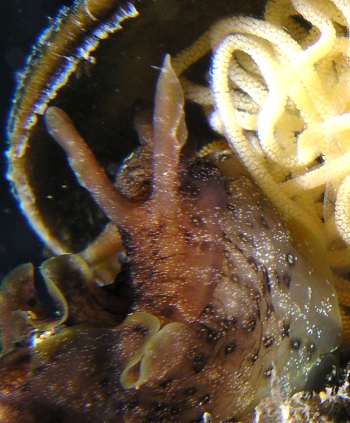
Sea Hares get their name from their supposed similarity in shape to the European Hare. In one of Dong Bum Koh's recent messages [#13760] concerning Aplysia oculifera I noticed this animal in one of the photos. It certainly looks like an alert hare, ears pricked, at the entrance to its burrow.
Locality: Hwa Soon, Jeju Island, Sth Korea. Depth: 4 m. Length: About 50 mm. 19. Dec. 2004. Sandy bottom with Rock Wall. Photographer: Youn Byung Ro
Best wishes
Bill Rudman
Dangerous to dogs, yes, but what about to people?
April 13, 2005
From: John Vincent
Hello,
I have a question that has not been answered in the Forum. I live in Key Biscayne, Florida, and we tend to have a large population of sea hares. I have read in your Forum that the sea hare can be poisonous to dogs and to people that may eat them without properly cleaning them. My question, is, are they dangerous or poisonous to people (mainly children) if one was to pick up a sea hare, or play with it in the water, without any protection, such as gloves?
Thanks for the info, and your Forum is a great search tool. Keep up the great work.
An avid reader, and marine enthusiast,
John Vincent Gomez-Iglesias
Key Biscayne, Florida
JohnVincentGI@aol.com
Vincent, J., 2005 (Apr 13) Dangerous to dogs, yes, but what about to people?. [Message in] Sea Slug Forum. Australian Museum, Sydney. Available from http://www.seaslugforum.net/find/13509Dear John,
Species of Sea Hares are found throughout the world, often in large numbers. In Florida, the two common species are Aplysia brasiliana and Aplysia morio. The strange thing is that it is only the Western Australian species, Aplysia gigantea, which has been accused of poisoning dogs. There have been a few accounts of Dolabella auricularia causing food poisoning, but it is suspected that it the result of some posionous algae in the internal organs. In general, Sea Hares are quite harmless, and are often favourite items in 'touch tanks' for children in aquarium displays. In our litigious world I am sure if there was any evidence of them causing harm to kids, someone would have sued by now. I don't know how many I have picked up alive without gloves or how many students over the years I have been with who have picked them up, but except for the special cases mentioned above, I would have no hesitation in saying they are harmless.
Best wishes,
Bill Rudman
Unknown worm mass
February 10, 2004
From: Rick Eastwood
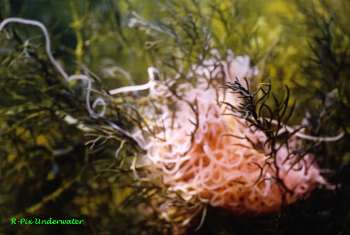
I have photographed the attached worm mass in 1.5 mtrs of water inside the Oak Park ocean baths at Cronulla, Sydney, Australia. It appeared to be attached to the seaweed growing on the sandy floor of the baths. The only movement coming from the mass was from the individuals - worms? - breaking away from the pack. The colour varied from a coral pink centre area to white extremities. The mass size shown would be approx.50mm across, say the size of a squash ball. Image taken with Sea & Sea MX10 with macro lens at F8..
Your help in identifying this would be appreciated.
Rick Eastwood
dicke@optushome.com.au
Eastwood, R., 2004 (Feb 10) Unknown worm mass. [Message in] Sea Slug Forum. Australian Museum, Sydney. Available from http://www.seaslugforum.net/find/12148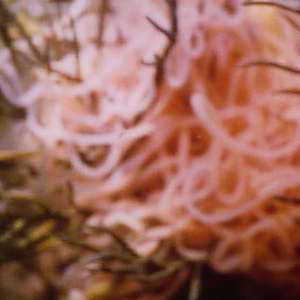
Dear Rick.
I am pretty sure this is the tangled egg ribbon of a Sea Hare. Have a look at photos on the Forum of the egg ribbon of Aplysia juliana [see #10759]. I can't see enough detail to be sure, but if it is a Sea hare egg ribbon you will see tiny eggs inside the pink cylinder much as in the photos of Aplysia fasciata [see #8159].
Best wishes
Bill Rudman
Sea Hares - strange behaviour.
January 12, 2004
From: Krista Recsei
Hi! I was wondering if I could get some info on some interesting behaviour my mum (Jacquie Recsei) and I observed by some Sea Hares. (i think sea hares, could be sea slugs?) They were in the large rockpools on a beach north of Sydney, on the coast next to Lake Macquarie [New South Wales, Australia]. It actually would be more accurate to say they WEREN'T in the rockpools. They were biggish (5-10cm long), very round, dark brown, with no real colouration other than that. During low tide, just as the tide began to come in, I noticed that maybe about fifty of these sea slug/hares were moving out of the water into the blazing hot sun. If moved back into the water they promptly moved themselves out again. Why would they be doing this? I read, on this site, about mass death with some sea slugs but it sounded different to this, as they didn't seem to be dying? Any information on this would be good.
Krista Recsei
pingleberry@hotmail.com
Recsei, K., 2004 (Jan 12) Sea Hares - strange behaviour. . [Message in] Sea Slug Forum. Australian Museum, Sydney. Available from http://www.seaslugforum.net/find/11856Dear Krista,
This doesn't sound like mass mortality to me. I'm afraid I can't give you an answer to why they were doing this but I can suggest a few possibilities.
The first possibility is that this has something to do with the heat. As you know we have been having many days over 30 deg C recently and this makes living intertidally a fairly risky business for animals which live there. At first sight, rockpools seem to be a good place to escape from the heat and the possibility of drying out, but unfortunately its not that simple. The water in rockpools heats up at low tide on a hot day. This means that there is less oxygen in the water and it also means that the sea weeds in the pool become quite stressed and can secrete chemicals into the water which are sometimes quite unhealthy for animal life. My first bet would be that the sea hares were finding life in the pools fairly uncomfortable and so were attempting to escape a slow cooking.
Another possibility is that they were responding to their normal biological rhythms or 'biologcial clock'. Many tidepool animals seem to become very active just before the the tide turns. Animals that have been hiding for 3 or 4 hours will suddenly appear and start crawling around. I know of no studies on why they do this but I suspect it is part of an activity rhythm they have which coincides with the return of fresh seawater as the tide returns.
People often make the mistake of thinking that we know everything about the environment. In fact as your strange sea hares show us, we still have a lot to learn.
Best wishes
Bill Rudman
Aplysia in Thailand
December 1, 2003
From: Dunyaporn Trachootham
Dear Sir
I'm a Thai student who now study Ph.d in Biomedical Sciences in Houston, Texas, USA. Now I work with a research group who use Aplysia as a model for nervous system study. However, I have commitment to come back to Thailand in the future.
Therefore, I would like to know whether I can find any Sea-hares like Aplysia, bubble shells like Bulla, side-gilled slugs like Pleurobranchaea in Thailand. I would need enough for research study. Could you give me some suggestions?
Dunyaporn Trachootham
dunyatra@yahoo.com
Trachootham, D., 2003 (Dec 1) Aplysia in Thailand. [Message in] Sea Slug Forum. Australian Museum, Sydney. Available from http://www.seaslugforum.net/find/11533Dear Dunyaporn,
There are certainly species of all that group that live in Thai waters but there are no guarantees that you could find an appropriate number of animals when you needed them. To provide a guaranteed supply of Aplysia for research was the main reason that facilities like the NIH-Aplysia Resource Facility in Miami, Florida were established. [http://www.rsmas.miami.edu/groups/sea-hares/]. They ship more than 25,000 captive bred animals a year to laboratories. I am not an expert in the field of nervous system research but I understand there are problems with using wild-collected animals because they habituate differently to captivity and so it is difficult to have suitable control specimens. It is also difficult to make comparisons between specimens whose history is unknown.
It is probably not possible to import captive bred animals when you return to Thailand so I would think it would be valuable if you were to spend some time before you returned to Thailand learning some basic techniques on keeping and breeding some of these animals in captivity. This would mean that when you returned to Thailand, you could collect some material locally and start your own captive bred colony.
Best wishes
Bill Rudman
Re: Sea Hares and Red Tides
November 20, 2003
From: Josh Anderson
Dear Bill,
Thank you!!! Your reply is exactly what we needed to know! Our kids were VERY excited this morning to read your response!
Josh Anderson
jandersononw@mail.olathe.k12.ks.us
Anderson, J., 2003 (Nov 20) Re: Sea Hares and Red Tides. [Message in] Sea Slug Forum. Australian Museum, Sydney. Available from http://www.seaslugforum.net/find/11455Sea Hares & Red Tides
November 19, 2003
From: Josh Anderson
Dear Dr Rudman
As you may know, the United States national high school debate topic focuses on U.S. ocean policy and marine natural resources.
Our school is researching a proposal by a neighboring school to solve for red tides by flooding the area with sea hares. As I am high school debate coach and not an expert on ocean studies, I could not begin to determine the scientific validity of the proposal.
If you are willing, would you mind spending a moment to help me understand -- to whatever degree your day allows -- the feasibility of this proposal? We would be most grateful for your help.
We would also welcome any materials that you think might be helpful for high school students researching sea hares and/or red tides. Thank you for any assistance you may be able to provide!
Josh Anderson
Olathe Northwest High School
Olathe, Kansas, U.S.A.
jandersononw@mail.olathe.k12.ks.us
Anderson, J., 2003 (Nov 19) Sea Hares & Red Tides. [Message in] Sea Slug Forum. Australian Museum, Sydney. Available from http://www.seaslugforum.net/find/11444Dear Josh,
I guess you want a quick answer. I'm afraid the red tide part of the story is a bit outside my field of expertise other than to say it is caused be microscopic phytoplankton - ie one-celled plants floating in the sea. I've listed a couple of web sites below but there are many
more:
• http://www.marinelab.sarasota.fl.us/~mhenry/WREDTIDE.phtml
• http://www.whoi.edu/redtide/
Sea Hares don't eat phytoplankton - they feed on macroalgae - that is seaweeds attached to the bottom. See Sea Hares Page for links to much more information.
So basically they would have no interest in red tides and in the low oxygen conditions caused by the red tide organisms they would most likely die and their carcases would add to any pollution
Hope that helps
Good Luck with your debate
Bill
Re: Sea Hare from Hawaii
October 8, 2003
From: Dee Wamock
Just wanted to say a belated thanks for your help in figuring out this was a Sea Hare from pics of a rather "far gone" specimen. So far I haven't seen any live ones but will continue to watch for them on our reef. Thanks again, you run a wonderful "service" here on line with great tact and humor and lots of good info.
Aloha,
Dee
BeachDee@hotmail.com
Wamock, D., 2003 (Oct 8) Re: Sea Hare from Hawaii. [Message in] Sea Slug Forum. Australian Museum, Sydney. Available from http://www.seaslugforum.net/find/11108Sea Hare eggs
September 12, 2003
From: Angie Jones
This is a basic question and I hope the answer isn't too difficult. I am a homeschooling mom and my children just finished a unit study on the ocean. It was designed to be very broad but somehow we have gotten technical. We found some conflicting information about Sunfish and Sea Hares. One book said the Sunfish laid the most eggs of all fish and the other said the Sea Hare lays the most eggs. Anyone know who is right? Try to keep it simple. My children are 8 and 6.
Thanks,
Angie
jones327@bellsouth.net
Jones, A., 2003 (Sep 12) Sea Hare eggs. [Message in] Sea Slug Forum. Australian Museum, Sydney. Available from http://www.seaslugforum.net/find/10950Dear Angie,
I'm not sure what question you are trying to answer but I suspect there is no conflict in the information you have found. I have no idea how many eggs a Sunfish lays but I am happy to accept that it 'the most eggs of all fish'. Since Sea Hares are not fish then the number of eggs are Sea Hare lays does not conflict with anything you say about the Sunfish. Sea Hares are specialised snails, which are Molluscs [including, squid, octopus, clams, snails etc, etc]. Sea Hares certainly can lay a lot of eggs - See the earlier message discussing the number of eggs one species of Sea Hare lays.
Best wishes,
Bill Rudman
Sea Hare from Hawaii
August 25, 2003
From: Dee Wamock
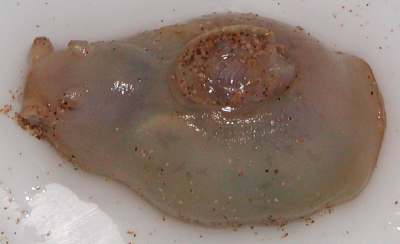
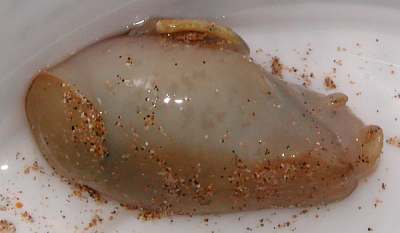
Aloha,
Found this creature on Kamaole Beach 1 in South Maui, Hawaii, this morning Friday 22 August 03, washed up on the sandy beach as tide receding. After ascertaining that it was, unfortunately, lifeless, took it home, took pics which I've attached 2. My only reference book is HAWAII'S SEA CREATURES by John P. Hoover and I'm an amateur with lots of questions. The book briefly describes a few cephalaspideans and although my find is colorless, the picture of Haminoea cymbalum in the book looked similar enough in general structure to make me believe I may have found a type of bubble shell. Do they lose color after death or would this just be a colorless species? I can see a faint dark-greenish shadow and mottling inside. Are bubbles soft on the exterior, because when I gently probe with a toothpick, it is fleshy-soft on the exterior, except for a hard spot on the little flap on its back. Or is it something totally different?
My name is Dee and I live next to the beach on Maui and walk it most mornings and also snorkel and dive our reef but haven't seen many sea slugs. As I learn more I may be able to spot them better. I am not a trained biologist, my BA is in anthropology but I've always been fascinated with nature and wanted to find answers and know about things. Haven't tried to dissect my find yet (it's in the fridge). My husband would probably appreciate my figuring out what this is right away so it leaves the kitchen but I have to know so will await enlightenment...
Thanks for any help.
BeachDee@hotmail.com
Wamock, D., 2003 (Aug 25) Sea Hare from Hawaii. [Message in] Sea Slug Forum. Australian Museum, Sydney. Available from http://www.seaslugforum.net/find/10826Dear Dee,
This is a Sea Hare. It is definitely dead and beginning to swell as decomposition occurs. The flap on the back is the mantle, and the hard plate inside is the thin shell. The mantle and shell are usually covered, or partially enclosed by parapodial flaps, but I guess they have partly rotted away. From the lower photo you can see a sort of disc at the back of the foot. This would suggest this is Aplysia juliana, but I can't be 100% sure. If you follow the links indicated you will find planty on the Forum about Sea Hares
Best wishes,
Bill
Are Sea Hares in Mexico edible?
August 11, 2003
From: Pepe Herrera
Hello, my name is Pepe and I live in La Paz, Baja Mexico. I have seen a lot of Aplysias all over La Paz Bay and I just wonder if you can eat them as the Sea Cucumber I would like to have some information about it and if they are edible, how are they processed Thank you.
Pepe
buzosdelgolfo@hotmail.com
Herrera, P., 2003 (Aug 11) Are Sea Hares in Mexico edible?. [Message in] Sea Slug Forum. Australian Museum, Sydney. Available from http://www.seaslugforum.net/find/10664Dear Pepe,
I suspect if Sea Hares in Mexico were edible then people would already be eating them. Some communities in the Pacific eat Dolabella auricularia, but as you will see if your look at the messages on that page, some cases of poisoning have occurred. In Western Australia, a large Sea Hare Aplysia gigantea has caused the deaths of dogs when they are washed up on beaches, so all things considered I think it would be best to leave them alone. For other information of eating sea slugs, go to the Recipes? Page.
Best wishes,
Bill Rudman
Sea Hares [Aplysia] in Channel Ids
February 18, 2002
From: Stephen R Hoskins
Dear Bill,
Thanks for posting my question on the Seaslug Forum. I wonder if you might post a second one?
Could any readers located on the UK Channel Islands e-mail me if they spot Aplysia sp [Sea Hares] coming in-shore to breed in the next 6 weeks, as I'm NOT located on the islands. I'd be most grateful to receive the geographical location, time and approximate numbers.
Many thanks Bill.
Yours,
Stephen.
SRH@4TheNet.co.uk
Hoskins, S.R., 2002 (Feb 18) Sea Hares [Aplysia] in Channel Ids. [Message in] Sea Slug Forum. Australian Museum, Sydney. Available from http://www.seaslugforum.net/find/6312Dear Stephen,
Your question raises the interesting question about whether Sea Hares actually migrate inshore for breeding. Have a look at the Mass Mortality Page for some discussion and links on the topic.
Best wishes,
Bill Rudman
Genetic phylogeny of Aplysia in the UK
February 8, 2002
From: Stephen Hoskings
I am interested in tracing the genetic phylogeny of Aplysia living around the Channel Islands by sampling adults coming into the shallows to breed around Easter time and performing DNA fingerprinting. Does anyone know whether any such studies have been conducted anywhere on Aplysia?
Very many thanks in advance.
Dr Stephen Hoskings
SRH@4TheNet.co.uk
Hoskings, S., 2002 (Feb 8) Genetic phylogeny of Aplysia in the UK. [Message in] Sea Slug Forum. Australian Museum, Sydney. Available from http://www.seaslugforum.net/find/6184Dear Stephen,
Perhaps you should contact Mónica Medina [details on the Participants Page] who has looked at population genetics in Aplysia californica.
Best wishes,
Bill Rudman
Genetic Studies of Sea Slugs
March 26, 2001
From: Eric Diano
Hello. I am a Undergraduate studying molecular and environmental biology at the University of California, Berkeley.
I am taking a molecular and genetics seminar on techniques for studying animal behavior. One assignment is to prepare a mock research grant proposal. I am fascinated by Sea Hares in general and wanted to propose some sort of genetic study of the animals, however I have been unable to find much of this type of research.
Can you point out any genetic research that you know of? Or suggest any type of interesting behavior which could benefit from such an analysis? Doing something like determining relative variablity of populations seems boring.
THANK YOU
Eric Diano
tanuki@uclink.berkeley.edu
Diano, E., 2001 (Mar 26) Genetic Studies of Sea Slugs. [Message in] Sea Slug Forum. Australian Museum, Sydney. Available from http://www.seaslugforum.net/find/4036Dear Eric,
Does your genetics study have to be a study of animal behaviour? I thought the relationship between genes and behaviour, at least in humans, was still a field of continuing debate if not open warfare. To attempt to study it amongst invertebrates, whose behaviour we scarcely understand, may be a bit much. I am sure you are aware of the work of the pioneering work of Kandel and many others who have used Aplysia californica to investigate how brains function and 'learn' and cause 'behaviour' but I don't know of any work where the brains of different genetic strains of Aplysia have been compared.
If on the other hand you are interested in any genetic study, and cost is no object, why not look at some of the Sea Hares which are thought to have worldwide distributions. Are they really the same species or not? Take a 'species' that is today found in the Caribbean, the Mediterranean, the Indo-West Pacific and east Pacific. While populations on both sides of the Panama isthmus may still be reproductively viable, the Atlantic and Pacific populations have been isolated for a much longer period. It would certainly be interestng to study.
A few Sea Hares which have very large distributions include:
•Aplysia dactylomela
•Aplysia juliana
•Bursatella leachi
•Stylocheilus striata
•Stylocheilus longicauda
Perhaps you should contact Mónica Medina [details on the Participants Page] who has looked at population genetics in Aplysia californica.
Best wishes,
Bill Rudman
Information about Sea Hares
March 12, 2001
From: Ray and Danny
My friend and I were fishing on a beach and I saw a sea hare but at first I thought it was a conch out of its shell until it squirted me with ink so i left it alone. The next week we saw 2 more so we decided to look for more and we found 47 sea hares and the biggest one weighted about 10 pounds. So what we were wondering how does a blob get to weigh 10pds.? What do they eat? Which is the male and which is the female?
Ray and Danny
barracuda9000@aol.com
Ray and Danny, 2001 (Mar 12) Information about Sea Hares. [Message in] Sea Slug Forum. Australian Museum, Sydney. Available from http://www.seaslugforum.net/find/3924Dear Ray and Danny,
Good question. Have a look at the Sea Hares Page for some general information. Basically they are herbivores, feeding on various sea weeds. They can grow very quickly if conditions are right and there is a species in California called Aplysia vaccaria which can grow to about 1 metre long and can weigh nearly 14kg [approx 30 pounds].
I am not sure where in the world you were fishing, but sometimes storms can wash large numbers of these animals up on to beaches where they unfortunately die. If you look at the page on Aplysia morio you will see there have been a lot of messages from Florida reporting just such a washup.
Now to your male & female question. Like all sea slugs, Sea Hares are hermaphrodites, which means they have fully functional male and female parts. During mating they can act as either the male or the female partner, and sometimes they mate in chains of three or more. When mating in chains the anterior animal acts just as a female and the most posterior animal as a male, but the ones in between act simultaneously as male and female. Have a look at the Sea Hares mating page.
Best wishes,
Bill Rudman
Overview of Aplysia reproduction
December 30, 2000
From: Moira Rankin
Hi! I'm writing a paper on the physiological control of Aplysia reproduction. I'm finding lots of info on the various aspects but I'm having trouble tying it all together. Could you please tell me the connections between Egg laying hormone, the pheromones involved, bag cells and the nervous system in reproduction? I know that seems like a hell of a lot but any help would be appreciated!!!
Thanks
Moira Rankin
moirarankin@hotmail.com
Rankin, M., 2000 (Dec 30) Overview of Aplysia reproduction. [Message in] Sea Slug Forum. Australian Museum, Sydney. Available from http://www.seaslugforum.net/find/3300Dear Moira,
When you say you are writing a paper does that mean you are going to publish a research paper or is this for a university assignment?
Normally I would offer to help but I have a huge backlog of questions on the Forum so am reluctant to spend time on someone else's research. Here are a few references worth looking at
• Audesirk, TE (1979) A field study of growth and reproduction in Aplysia californica. Biol. Bull. 157(3): 407-421.
• Bebbington, A., Thompson, TE. (1969) Reproduction in Aplysia (Gastropoda, Opisthobranchia). Malacologia, 9(1): 253.
• Dudek, FE., Soutar, B., Tobe,S S. (1980) Reproduction in Aplysia californica: correlations between egg laying in vivo and egg release in vitro. Can. J. Zool., 58(11): 2163-2166.
• Painter, SD., Chong,MG., Wong,MA., Gray,A., Cormier,JG., Nagle,GT. (1991) Relative contributions of the egg layer and egg cordon to pheromonal attraction and the induction of mating and egg-laying behaviour in Aplysia. Biol. Bull., 181: 81-94.
• Switzer-Dunlap, M., Hadfield, MG., (1979) Reproductive patterns of Hawaiian Aplysiid gastropods. In: Reproductive Ecology of Marine Invertebrates, Belle W. Baruch Library in Marine Science, No 9. (Ed: Stancyk,SE),, 199-210.
• Thompson, TE., Bebbington, A. (1969) Structure and function of the reproductive organs of three species of Aplysia (Gastropoda: Opisthobranchia). Malacologia, 7(2-3): 347-380.
• Susswein, AJ., Markovitch, S., Achituv, Y. (1993) Asymmetry of male and female mating in mixed-species groups of Aplysia fasciata Poiret and Aplysia brasiliana Rang (Mollusca: Gastropoda). Isr. J. Zool., 39: 213-229.
• Yusa, Y (1996) The effects of body size on mating features in a field population of the hermaphroditic sea hare Aplysia kurodai Baba, 1937 (Gastropoda: Opisthobranchia). J. Moll. Stud., 62: 381-386.
It would also be worth looking at Kandel's two books for a general overview and the place of the nervous system in reproduction.
Best wishes,
Bill Rudman
Sea Hares & egg laying
October 17, 2000
From: L. Rivard
I have Sea Hares from the Gulf of Mexico (Walton County)panhandle of Florida, USA. I would like to find more info. on these little creatures of the sea. They are depositing long twisting lines of eggs in the tank. How long will it be before they hatch? What would be the best food to feed them? What are some sites I can go to for more info.?
Thank you for any help. L.Rivard
lcr@digital.exp.com
Rivard, L., 2000 (Oct 17) Sea Hares & egg laying. [Message in] Sea Slug Forum. Australian Museum, Sydney. Available from http://www.seaslugforum.net/find/3165Dear L. Rivard,
By coincidence I have just posted a message on the Forum today about an article on how to culture Sea Hare larvae in an aquarium.
I am not sure if you have visited the Forum before but there is quite a lot of information on Sea Hares, about various aspects of their biology and about a number of different species. The information is not all neatly ordered because the Forum grows in areas determined mainly by the immediate interests of the participants.
If you go to the General Topics Index you will find a list of pages about Sea Hares. All those pages have attached messages and discussions which are worth a look at.
Best wishes,
Bill Rudman.
Participant information
October 5, 2000
From: Sara Black
Please add me to your participant page. You have a really marvelous site!
I am a graduate student at Texas A&M University-Galveston. I am obsessed with all things Aplysia and am currently working on inter-species breeding between two tropical species.
Sara Black
seahare15@yahoo.com
Black, S., 2000 (Oct 5) Participant information. [Message in] Sea Slug Forum. Australian Museum, Sydney. Available from http://www.seaslugforum.net/find/3115Dear Sara,
I've added you to the Participants Page. I usually just add such details to the Participants List without including the information amongst the daily messages. However it seems a good time to advertise the list and ask any one who is not on it to seriously consider sending some details. There is no cost and no obligation, but it is a good way to let other like-minded people know you exist. Have a look at the 'visitor stats' I have posted today to show just how many people read the Forum regularly.
And Sara, your research on Aplysia sounds very fascinating. If you would like to share any background information on your work, photos of your species etc, it would be very welcome.
Best wishes,
Bill Rudman.
Where can I find an Aplysia book?
September 29, 2000
From: Suzanne Grosso-Mennecke
Dear Dr. Rudman,
I am very interested in a book I found in my college library at Stony Brook University in New York. The title of the book is Behavioral Biology of Aplysia by Eric R. Kandel.
Do you know where I can find it?
Thank you for your help.
Suzanne Grosso-Mennecke
sueatislip@yahoo.com
Grosso-Mennecke, S., 2000 (Sep 29) Where can I find an Aplysia book?. [Message in] Sea Slug Forum. Australian Museum, Sydney. Available from http://www.seaslugforum.net/find/3084Dear Suzanne,
You will find references to Kandel's two books throughout the Forum. You'll find full references in an earlier message if you need them.
Since they were published over 20 years ago it is unlikely they will still be in stock but I guess you should just go to a good bookstore and see if they can track it down for you. Or contact the publisher. Out of curiosity I had a look at the Amazon online site and they say its out of print but you can ask them to try and find a used copy for you at no obligation.
Best wishes,
Bill Rudman.
Sea Hares and Tide Pools
September 24, 2000
From: Will Akers
Hi,
I am 10 years old and looking for information on Sea Hares and especially how they react to different waters/tides and temperatures in a tide pool setting. I am doing a report in my 5th grade class and cannot find this information. Your information and pictures in Sea Slug Forum have been very helpful otherwise...
thank you...
Will Akers
akers@telis.org
Akers, W., 2000 (Sep 24) Sea Hares and Tide Pools. [Message in] Sea Slug Forum. Australian Museum, Sydney. Available from http://www.seaslugforum.net/find/3045Dear Will,
Although we often find Sea Hares in the intertidal region they are not really well adapted for life there. They can survive being exposed at low tide if they are in the shade and kept damp, by being covered with sea weeds. Apparently as long as their skin is damp they can still breathe. However they can't live long like this and will die in a few hours or if caught exposed to the sun where they dry out. Sometimes after storms large numbers are found washed up on beaches at low tide where they die before the tide returns.
Basically all slugs are snails that have lost their shells. Snails that live in the intertidal region often have special adaptations to stops them drying out and getting overheated. For exmaple, many snails have an operculum or door which closes tightly to prevent water loss at low tide. One special example are the periwinkle snails (Littorinidae) which live high on the shore and are often uncovered for 10 days or more on hot rocks. They survive by sealing their shells to the rocks with a sticky mucus and then they withdraw their foot further into the shell so it is no longer in contact with the hot rock.
When you are a slug unfortunately, there is no way to stop drying out if you are caught uncovered at low tide. If you look at the Sea Hare shell Page you will see it is just a flat plate hidden in the skin. Certainly no use for protection. It is a bit like the few bones at the base of our backbone called the coccyx. They are all that is left of our tail, but not much use for swinging through the trees.
Also have a look at the pages on What is a Slug? and How snails became slugs.
Good Luck with you report,
Bill Rudman.
More Sea Slug Hitchhikers
September 23, 2000
From: Andrew Trevor-Jones
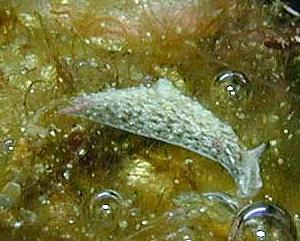
I have two species of opisthobranchs which came as hitchhikers on rocks from the GBR, Queensland (exact locality unknown). I have pictures attached below.
Andrew Trevor-Jones
atj777@attglobal.net
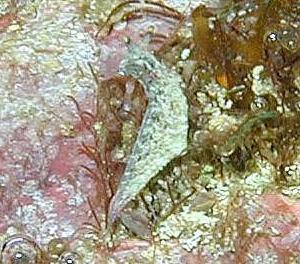
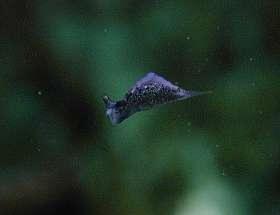
Dear Andrew,
If you see the messages about Scutus it looks like grazing herbivores are quite good at surviving great upheavals in their lives.
I am pretty sure your animals are juvenile Sea Hares, probably species of Aplysia. It is possible the blackish one is a sacoglossan (Elysia?) but I can't be sure. I am sure they will survive in your aquarium feeding on algae so why don't you just keep an eye on them and when they grow a bit bigger send me another photo.
Best wishes,
Bill Rudman.
I need information on Sea Hares
July 13, 2000
From: Chantelle
Hello,
I was wondering if it was possible for you to help me in locating information about the Sea Hare under the different headings: respiration, eating, moving, self protection, structural support.
Thank you,
Chantelle
lump@cyber.net.au
Chantelle, 2000 (Jul 13) I need information on Sea Hares. [Message in] Sea Slug Forum. Australian Museum, Sydney. Available from http://www.seaslugforum.net/find/2704Dear Chantelle,
I guess you have an assignment to do for school? or university? However without some indication from you it is difficult for me to decide how much you already know.
There is quite a lot of information on Sea Hares in the Forum. If you go to the Sea Hares page you will find some background information and a list of other pages with more information. Make sure to read the messages and answers on each page because they also have a lot more information. (Don't forget the messages below yours on this page).
If, after reading all those pages, there are some points you are not clear on, please let me know and I will try and help.
Best wishes,
Bill Rudman.
Learning in Aplysia
June 29, 2000
From: Raphaël Favre
Dear professor,
My name is Raphaël Favre and I'm a student in biochemistry at the Univerity of Geneva in Switzerland. I've to do a study about long-term facilitation in Aplysia. Could you please recommand me any articles that treat about the enzymatic mechanisms of LTP ?
I thank you a lot, your web site is really great,
Raphaël
pharias@hotmail.com
Favre, R., 2000 (Jun 29) Learning in Aplysia. [Message in] Sea Slug Forum. Australian Museum, Sydney. Available from http://www.seaslugforum.net/find/2616Dear Raphaël,
I appreciate your thought that I can answer any question on Sea Hares, but the truth is that although research on how brains work fascinates me, I must admit I have no time to keep up with it. I have relied on the comprehensive, but somewhat dated reviews of Kandel, which I have referred to in an earlier message, and the occasional article in magazines such as Science. To those of you who at a complete loss with the question, LTP or long term potentiation is a name for a process that increases the strength of the synaptic connections between neurons. In one model of how memory and learning works it is thought that 'learning' is the result of the build up of specific synaptic connections or pathways between neurons and through the accumulation of such connections, brains learn things and memories develop.
As I've have said elsewhere in the Forum, Aplysia, with a relatively simple nervous system and large nerve cells has proved an ideal animal for use in the study of learning.
Unfortunately Raphaël, I can't help with any recent reviews on the subject. If you find one, could you let me know so I can add it to the Forum. Or perhaps when you finish your review you could write us a summary on the subject, remembering of course that most of us have never developed neural pathways to deal with this area of science.
Best wishes,
Bill Rudman.
Swimming Aplysia from Philippines
June 24, 2000
From: Erwin Koehler
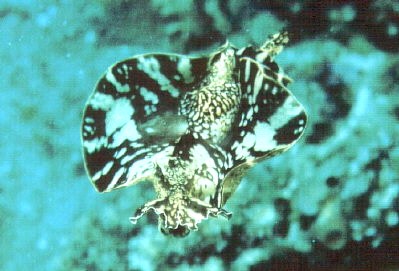
Dear Bill,
Here is a swimming Aplysia from the Philippines, Negros Oriental Is., Sibulan housereef, March 2000, depth 1 m, size approx. 12 cm.
This photo is by Hans-Hermann Harms.
Erwin
Medslugs.Koehler@t-online.de
Koehler, E., 2000 (Jun 24) Swimming Aplysia from Philippines. [Message in] Sea Slug Forum. Australian Museum, Sydney. Available from http://www.seaslugforum.net/find/2610Thanks Erwin,
It could be Aplysia oculifera but I am not sure. Whatever the species is, it is certainly a good shot of one swimming.
Best wishes,
Bill Rudman.
Galapagos Sea Hare
June 19, 2000
From: Mark Blum
Hi Bill,
I wonder if you can help me with the scientific name(s) of the Sea Hare species found in the Galapagos Islands?
Thank you,
Mark Blum
Undersea3d.com
markb@redshift.com
Blum, M., 2000 (Jun 19) Galapagos Sea Hare. [Message in] Sea Slug Forum. Australian Museum, Sydney. Available from http://www.seaslugforum.net/find/2593Dear Mark,
If you are trying to identify a Sea Hare you have found in the Galapagos Ids it would be better if we could see a photo of it. There may be more than one species found there, and even if I could give you a list of those that have been found there, it does not necessarily mean that other species do not also live there.
I haven't a list of those that have been found there but perhaps someone reading this can help us.
Best wishes,
Bill Rudman.
Sea Hares from the Red Sea
May 25, 2000
From: Alaa youssry Moustafa
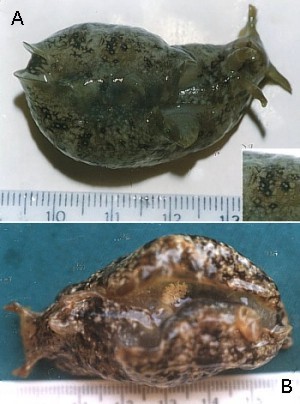
Dear Dr.Bill
Let me inform you that, I have been working on sea hares for 5 years now. I have got my M.Sc.on the biology and the chemical defence of sea hares collected from the Red Sea, EGYPT (Aplysia dactylomela, A. cornigera [PHOTO B]], A. oculifera [PHOTO A], Dolabrifera dolabrifera [PHOTO: E] and Petalifera petalifera). I hope to continue in the same line in the study of the Doctoral degree.I need your advice and your suggestions.
My study includes:
1- Making a survey of sea hares collected from the Red sea, we identified six species, studied their taxonomic characters, presence, feeding habitat.
2- Detailed study of the anatomy, histology, histochemistry of the reproductive, digestive, nervous systems of Aplysia dactylomela, Dolabrifera dolabrifera also, with TEM and the SEM.
3- determined the LD50 of a crude extract of the digestive gland of the previous species and show its pharmacological characters.
4- isolation of two different algae from the filter chamber (Gyminodinum)[PHOTO: D] from D. dolabrifera and the green algae Oedogonium [PHOTO: C] from A. dactylomela.
Also, we derived some aliphatic terpenes from their digestve glands. I hope to study in my PHD the chemical defence.
Yours
Alaa youssry Moustafa
Zoology dept.
Faculty of Science, Sohag 82524
South Valley University,
Egypt
Alaa_youssry@Yahoo.com
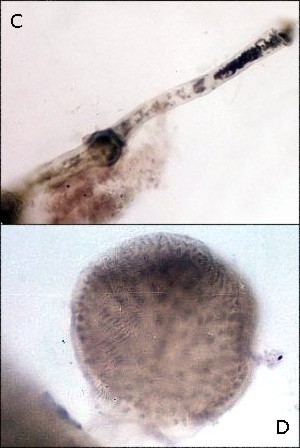
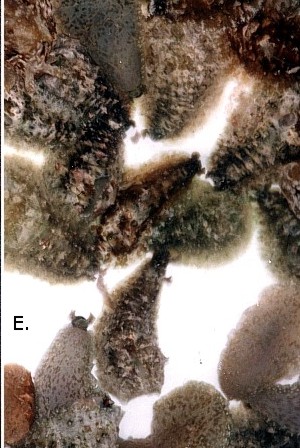
Dear Alaa,
I am glad to hear of your interest in Sea Hares. Any questions, observation, photos etc are welcome.
I am also sure that now other workers know of your interest they will contact you directly.
Look forward to hearing from you,
Bill Rudman.
'Teeth' in the gut of Bursatella
March 10, 2000
From: Jack Rudloe
Dear Dr. Rudman:
Do you have any information on the "teeth" in the crop of Bursatella and Aplysia? There's an orange crop, or stomach that has a dozen or so triangular teeth-like structures that appear to be made out of some unusual transluscent yellow or green material that I find intriguing. This year in the northeastern Gulf of Mexico, we've got swarms of Bursatella washing up on the beaches, and I was wondering if anyone ever looked at the "teeth" for some unique bio-material. Any information will be appreciated, and thanks for having your slug website. See ours at www.Gulfspecimen.org
Thanks,
Jack Rudloe,
President
gspecimen@sprintmail.com
Rudloe, J., 2000 (Mar 10) 'Teeth' in the gut of Bursatella. [Message in] Sea Slug Forum. Australian Museum, Sydney. Available from http://www.seaslugforum.net/find/2068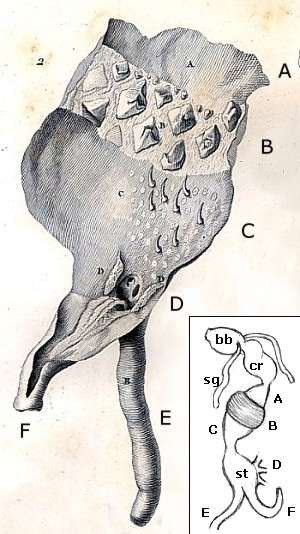
Dear Jack,
The gut of the sea hares follows a very similar design throughout the Order. I have used a very old drawing of Cuvier's (1803) of the opened gizzard region to illustrate the arrangement [mainly because most people don't get a chance to see these old figures]. The inset is a sketch of mine to show the whole gut. In Cuvier's drawing many of the hooks in the filter chamber (C) are missing. They should form a dense band right around the chamber.
There is a muscular buccal bulb (bb), opening at the mouth, and it contains the broad rasping radular ribbon used to break off pieces of the algae it feeds. A pair of long salivary glands (sg) open into it. the oesophagus is a large extensible sac or crop (cr) in which pieces of algal food are stored before being crushed in the gizzard, which is broken into 3 regions (ABC). The first (A) is unarmed and presumably is just an anterior holding sac for partially digested food forced down from the crop. The second part of the gizzard (B) has a basal layer of circular muscle encircling the gizzard, and is lined with large chitinous pyramidal crushing plates which reduce the algal plates to fine pieces and a slurry of algal 'juice'. The third region (C) is lined with find recurved chitinous hooks which filter the crushed slurry of food, preventing large particles from moving further down the gut.
The stomach (st) is a very small chamber into which the ducts (D) of the digestive gland open. Also opening into the stomach are the caecum (F) and the intestine (E). Then stomach and caecum are lined with ciliated ridges and there is obviously a very complicated sorting process going on in the stomach, separating edible and inedible particles from the gizzard, and faecal and excretory products from the digestive gland. The caecum seems to be where the faecal pellets are formed.
This is probably more than you wanted to know. Suffice to say that the gizzard plates are of two sorts. A band of large crushing plates and then a region of relatively fine hooks packed close together to form a filter chamber.
Best wishes,
Bill Rudman.
Best wishes,
Bill Rudman.
Aplysia Osmoregulation
February 25, 2000
From: Myrtle
How does the Sea Hare (Aplysia) osmoregulate if taken from a 100% sea water solution and placed into a 95% solution of sea water and then returned to a 100% sea water solution?
Thank you for your help.
Myrtle
jaeger@4dcomm.com
Dear Myrtle,
The short answer is that Sea Hares, like all molluscs have a kidney whose main function, as in vertebrates, is to maintain the constancy of the internal environment by governing the body's water content, regulating the electrolyte balance of the body fluids, excreting wastes and conserving nutrients.
If you want a fuller account you should find a good book on mollusc physiology. A good summary can be found in Kandel, E. R. (1979): Behavioural Biology of Aplysia. San Francisco, W.H.Freeman & Co. 463pp.
Best wishes,
Bill Rudman.
Aplysia from Japan
February 17, 2000
From: Yasuhiro Shirai
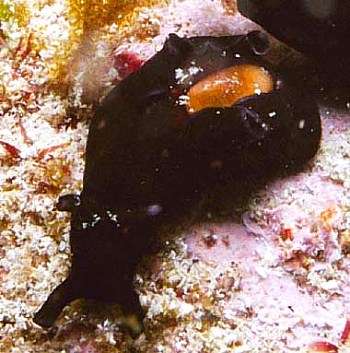
Dear Bill,
Thank you for your replies to my earlier messages. This opisthobranch crawled on rock.
I think it is an Aplysia species.
These animals had shell with their back like my photo.
Could you please identify this animal for me.
Data:
Location: Shima Pref. Mie Japan (Kii Peninsula east coast)
Length: 30mm
Water temperature: 13C
Date Jan. 2000
Depth: 5m
Crawling on rock
Best regards,
Yasuhiro Shirai
yasuhiro@e-net.or.jp
Shirai, Y., 2000 (Feb 17) Aplysia from Japan. [Message in] Sea Slug Forum. Australian Museum, Sydney. Available from http://www.seaslugforum.net/find/1894Dear Yasuhiro,
Yes this is a Sea Hare. It is a bit difficult identifying which species of Aplysia it is without a better idea of its shape. Both Aplysia juliana and Aplysia cf. parvula can have very dark, almost black, bodies and a horny brown coloured shell like in your photo.
Best wishes,
Bill Rudman.
Anatomy of Aplysia
January 28, 2000
From: Sylvia E. Jones
Dear Dr. Rudman,
I am a docent for the University of Florida's Whitney Laboratory and also a Marine docent for the University of New Hampshire. My husband and I are "Snowbirds" dividing our time between New England and Florida. I have recently become interested in Sea Hares, as one of the research Dr.s at Whitney is studying them. I like to be able to discuss these animals with the public when doing a marine animal zoo. I have been looking for a detailed drawing of the innerworkings of an Aplysia, so I can explain this to my fellow docents and to the public. I am also very curious, the more I learn about the creatures in the sea....the more I want to learn. I am a painter of flora and fauna as well...If it isn't "beneath your noise level" could you please tell me where I might find such a diagram/drawing? Is this email address one that I can write to the "Sea Slug Forum" ? I thank you for any help you can give. May you have a new year full of exciting new discoveries.
Sylvia E. Jones
Palm Coast, Florida
bandsjones@bestnetpc.co
Jones, S.E., 2000 (Jan 28) Anatomy of Aplysia. [Message in] Sea Slug Forum. Australian Museum, Sydney. Available from http://www.seaslugforum.net/find/1805Dear Sylvia,
The best background book for Aplysia is:
Kandel,E. R. (1979): Behavioural Biology of Aplysia. San Francisco, W.H.Freeman & Co. 463pp
It will probably be more than you need but the value of the book is that it puts the anatomy of the animal into its functional context and it also puts Sea Hares into their place in molluscan evolution. It should be available in university libraries, especially if they have Pyschology Department, as Sea Hares are now an important subject for behavioural studies.
I guess you have looked at the Sea Hare page in the Forum. It will lead you to the other relevant pages. You can either use my email address to write to the Forum or click the SEND A MESSAGE button on the Navigation Bar at the top and bottom of each page.
Best wishes,
Bill Rudman.
What is this?
January 3, 2000
From: FAbienne Bovis
Hi everyone,
I am trying to identify an animal which I saw in the South of Spain this summer.
It was swimming at the surface of the water in the port, which is about 5 ms deep. It is dark brown to black, about 15 to 20 cms long. It has a soft mantel which assures motion. It also has horns like a snail, and the underneath of the animal is similar to a slug or a snail. It can stick to a surface, and also move.
No one locally seems to know what it is. We put it in a bucket to observe and feel it, and then released it.
I would be very grateful if someone could help me identify it.
Thank you!
FAbienne Bovis
toebee@mercuryin.es
Bovis, F., 2000 (Jan 3) What is this?. [Message in] Sea Slug Forum. Australian Museum, Sydney. Available from http://www.seaslugforum.net/find/1715Dear Fabienne,
I'm not sure if ypu have given me enough information to identify your animal but if it was swimming then it was possibly a Sea Hare, some species of which can swim. Have a look at the information in the Forum on Sea Hares and have a look at the message today from Stephanie Clark which has a photo of a swimming Sea Hare.
If your animal didn't look like a Sea Hare, a rough sketch or drawing would help us identify it.
Best wishes,
Bill Rudman.
Sea Hare information
November 13, 1999
From: alexis
I'm doing a biology assignment on the adaptations of sea hares. The adaptations include: Behavioural, structural, and physiological adaptations. I was wondering whether you have any information useful for me.
Please respond by 14th November
Thank you
alexis
lex345@hotmail.com
Dear Alexis,
Looks like you left it to the last minute - a common student disease. I can't drop everything to meet your deadline but there is lots of information on Sea Hares throughout the Forum. As a first step go to the Sea Hares Page where you'll find a list of links to other related pages. At the bottom of each page [and below your message] you will find a series of messages and answers which you should look at because they contain quite a lot of material.
Also use the Search the Forum button in the yellow bar at the top of each message and the bottom of each page.
Good luck with your assignment,
I guess there is no point in saying start earlier next time,
Bill Rudman.
Rudman, W.B., 1999 (Nov 13). Comment on Sea Hare information by alexis. [Message in] Sea Slug Forum. Australian Museum, Sydney. Available from http://www.seaslugforum.net/find/1523Where in Europe is Aplysia available ?
November 7, 1999
From: Ulrich Storz
For research in behavioural biology, we want to introduce Aplysia in our institute. Despite its popularity, I have found it really difficult to obtain Aplysia specimens. I have checked all marine labs and field stations from Yugoslavia to Scotland but none seems to be able to provide Aplysia at this time of the year. The only provider I have heard of is The NIH resource facility in Miami, but the shipping cost would be very high.
Does anybody know a good source for Aplysia in Europe?
Thanks in advance,
sincerely
Ulrich Storz
Institute for Zoophysiology
Muenster University
Germany
storz@uni-muenster.de
Storz, U., 1999 (Nov 7) Where in Europe is Aplysia available ?. [Message in] Sea Slug Forum. Australian Museum, Sydney. Available from http://www.seaslugforum.net/find/1494